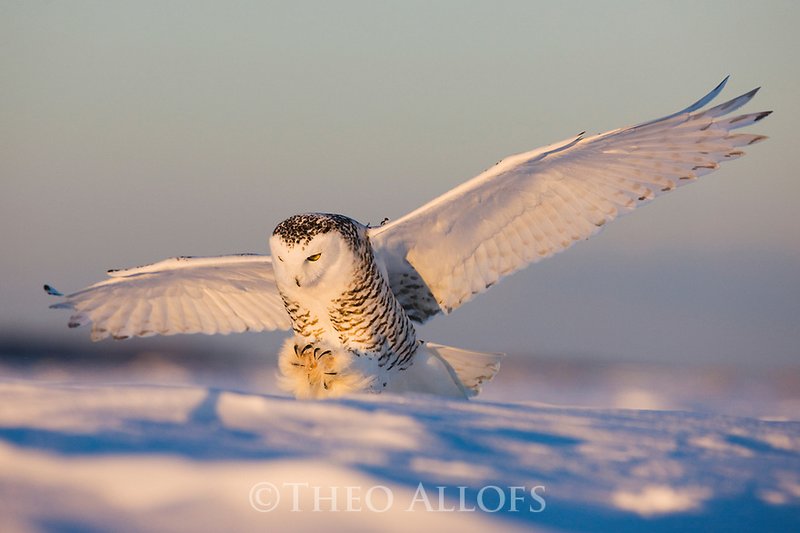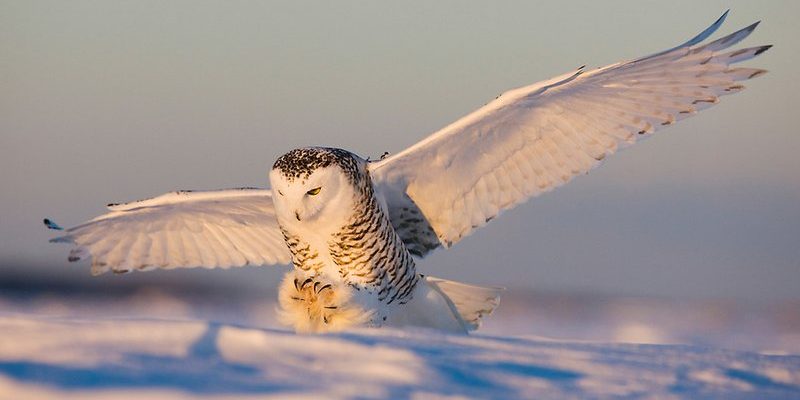
Snowy owls, with their bright white feathers and striking yellow eyes, are as iconic as they are skilled hunters. Unlike many birds, they do more than just hover or swoop down on their targets. They have developed a set of flying techniques that seamlessly blend grace with power. The environment they thrive in—vast, open tundras—further shapes their hunting strategies. In this article, we’ll break down the fascinating ways snowy owls fly and hunt, making it easier to appreciate their adaptation to harsh conditions.
Exceptional Flight Skills
Snowy owls are known for their silent flight, a feature that sets them apart from many other birds. Their feathers are adapted to minimize noise, allowing them to sneak up on unsuspecting prey. Imagine a stealthy ninja gliding through the night—this is what a snowy owl does. The edges of their wing feathers are serrated, creating turbulence that dampens sound. This ability to fly silently is crucial, especially in the dark tundra, where every sound echoes.
Let’s talk about their wing design. Snowy owls have broad, powerful wings that enable them to soar efficiently over large stretches of land. They use a series of gliding and flapping movements to navigate through various altitudes. When they want to gain speed, they flap their wings vigorously, while gliding helps conserve energy—just like when you coast downhill on a bike. This energy efficiency is vital in their Arctic habitats, where food can be scarce.
The snowy owl’s vertical takeoff is another impressive feature. When they decide it’s time to hunt, they can leap straight up into the air with remarkable strength. This allows them to gain altitude quickly and spot their target from above. Picture a cat pouncing from a high place—this is the snowy owl’s takeoff in action, ready to spot its next meal from a bird’s-eye view.
Hunting Strategies
Snowy owls primarily hunt during the day, which is a bit different from many other owls that prefer nighttime. The bright white color of their feathers makes them less visible against the snowy landscape, camouflaging them as they hunt. They often perch high on a post or hill, scanning the ground for movement. Their keen eyesight allows them to spot small mammals, like lemmings, from great distances.
Here’s the thing: snowy owls are opportunistic hunters. If a lemming is a bit too fast or too far away, they’ll adapt by targeting other prey, such as birds or even rabbits. This adaptability to their environment is essential for survival. So, if their favorite dish isn’t readily available, they’ll switch things up without missing a beat.
Once they spot potential prey, snowy owls utilize a technique called stooping. This is similar to a sudden dive, where they swoop down from their perch with incredible speed and precision. Imagine a baseball player sliding into home plate to avoid being tagged out—that’s how quick and agile these owls can be. Their powerful talons grip their prey firmly, ensuring a successful catch.
Unique Adaptations
Did you know that snowy owls have exceptional hearing? They can detect the faintest sounds made by their prey scurrying in the snow. This sharp auditory sense is essential, especially in the vast, quiet tundra. The ability to hear movements beneath layers of snow helps them pinpoint where to strike.
Their body insulation is another adaptation that keeps them warm in frigid temperatures. Snowy owls have thick feathers that provide excellent insulation. When temperatures plummet, these feathers trap heat close to their bodies, allowing them to remain comfortable as they hunt. Imagine wearing a cozy parka on a cold winter’s day—this is how these owls stay protected from the harsh Arctic chill.
Also, snowy owls have a distinctive hunting style where they can hover over a spot before diving down. This hovering allows them to zero in on their target more effectively, much like a drone hovering above a specific location. It’s this combination of patience and precision that makes them such successful hunters in their home territory.
Seasonal Migration and Hunting
Interestingly, snowy owls are known to exhibit irruptive migration patterns. This means they may travel further south during certain years if food becomes scarce in their Arctic homes. It’s more of a feast-or-famine scenario—when food is plentiful, they stay close to the tundra, but when resources dwindle, they venture to areas like Canada and even the northern United States.
During migration, their hunting techniques remain largely the same, but they may encounter different prey. In these southern expanses, they can hunt smaller rodents or even birds they might not have seen in their usual habitats.
Knowing they’re on the move can change their hunting behavior, too. They become more adaptable, adjusting to the availability of different types of prey. This flexibility is vital for their survival as they navigate changing landscapes and climates.
The Role of Snowy Owls in Their Ecosystem
Snowy owls play a crucial role in maintaining the balance of their ecosystem. By controlling small mammal populations, they help ensure that the food chain remains stable. Fewer lemmings can lead to an overgrowth of vegetation, which could disrupt the habitat for other species. So, in a way, snowy owls are like the keepers of the tundra.
Their presence can also indicate the health of the environment. As carnivores at the top of the food chain, snowy owls can reflect changes in prey populations and, subsequently, the overall ecosystem. When scientists study snowy owl populations, they can gather important clues about the state of their habitat and the impacts of climate change.
Additionally, these owls bring a touch of magic to our world. Their beauty and fascinating behaviors remind us of the intricate web of life that connects all living things, both in the Arctic and beyond.
In conclusion, the snowy owl’s flying and hunting techniques are a perfect blend of skill, adaptability, and beauty. From their silent flight to their effective hunting strategies, these raptors have evolved to thrive in some of the harshest conditions on Earth. As they navigate their snowy landscapes, they remind us of the wonders of nature and the intricate balance of ecosystems. So, the next time you think about snowy owls, remember that they are not just birds of prey but essential players in their environment. Who wouldn’t be fascinated by the majestic dance of these incredible hunters?

